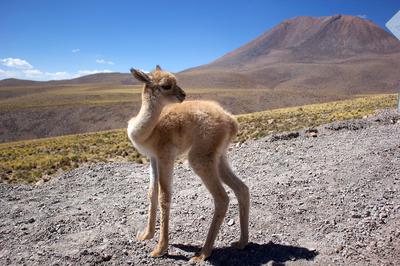The adorable Vicuña: Bolivia for Kids
by Kricket
(BoliviaBella.com)
Hello and welcome to my second post on Bolivia's Wacky Wildlife, which I cover once a month. Last time we covered the pink birds from the Andes Mountains called the Andean Flamingo. Today we're covering another rare species related to llamas and alpacas: the vicuña (pronounced vee-coo-nya).
Vicuñas live in the high alpine areas of the Andes. They are related to the llama and are thought to be the wild ancestors of domestic alpacas. They produce small amounts of very fine wool, which is VERY expensive because you can only shear it every THREE years and it must be caught from the wild.
When knitted, the result is really soft and warm. The Incas valued these animals for their wool and in some communities it's illegal for anyone but royalty to wear vicuña wool garments.
During both the rule of the Incas, and still today, it was illegal to hunt vicuña, but they were still hunted. There was a time in 1974 when they were classified as endangered; at that time there were only about 6,000 left. Luckily today the population has recovered to about 350,000.
Vicuñas live exclusively in South America, mostly in the central Andes at a height of 3,200 to 4,800 meters above sea level. They can be found in northwest Argentina, Bolivia, northern Chile, with a few in central Ecuador, and Peru where the largest number live.
The Vicuña is the smallest in the camelid family, which consists of llamas, alpacas, camels of course, and more. They have large eyes that face foward and slightly triangular ears on a small wedge shaped head, on a large neck. They have long legs and walk on the soles of their feet instead of the toes. This allows them to walk better on rocks and gravel.
So that was the Vicuña for you guys, and doesn't it just look so cute?!?
Now here's a question for you. The Vicuña walks on the soles of it's feet, right? How do you think it would feel for you to only walk on the soles of your feet all the time?
Vicuñas live in the high alpine areas of the Andes. They are related to the llama and are thought to be the wild ancestors of domestic alpacas. They produce small amounts of very fine wool, which is VERY expensive because you can only shear it every THREE years and it must be caught from the wild.
When knitted, the result is really soft and warm. The Incas valued these animals for their wool and in some communities it's illegal for anyone but royalty to wear vicuña wool garments.
During both the rule of the Incas, and still today, it was illegal to hunt vicuña, but they were still hunted. There was a time in 1974 when they were classified as endangered; at that time there were only about 6,000 left. Luckily today the population has recovered to about 350,000.
Vicuñas live exclusively in South America, mostly in the central Andes at a height of 3,200 to 4,800 meters above sea level. They can be found in northwest Argentina, Bolivia, northern Chile, with a few in central Ecuador, and Peru where the largest number live.
The Vicuña is the smallest in the camelid family, which consists of llamas, alpacas, camels of course, and more. They have large eyes that face foward and slightly triangular ears on a small wedge shaped head, on a large neck. They have long legs and walk on the soles of their feet instead of the toes. This allows them to walk better on rocks and gravel.
So that was the Vicuña for you guys, and doesn't it just look so cute?!?
Now here's a question for you. The Vicuña walks on the soles of it's feet, right? How do you think it would feel for you to only walk on the soles of your feet all the time?
Video source: https://youtu.be/4eUi5TPWSoE
Submitted 2015-02-26

